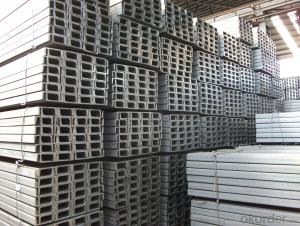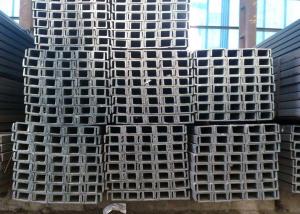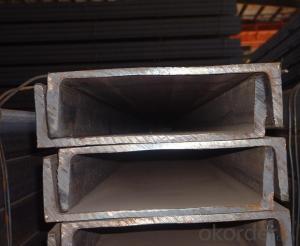Hot Rolled Channel Steel Module of A36 SS400 S235
- Loading Port:
- Tianjin
- Payment Terms:
- TT OR LC
- Min Order Qty:
- 4000 PCS
- Supply Capability:
- 250000 PCS/month
OKorder Service Pledge
OKorder Financial Service
You Might Also Like
Hot Rolled Channel Steel Module of A36 SS400 S235 Details
| Standard: | AISI,ASTM,BS,DIN,GB,JIS | Dimensions: | 50*37*4.5mm-400*104*14.5 | Grade: | A36 SS400 S235JR Q235 Q345 |
| Place of Origin: | China (Mainland) | Brand Name: | CNBM | Model Number: | channel steel A36 SS400 S235JR |
| Shape: | U Channel, U Channel | Application: | construction material or bracket | Perforated Or Not: | Not Perforated |
| Length: | 5-12m | payment term: | T/T.L/C. D/A, D/P and so on | Ceritificates: | CIQ and Mill Certificates |
| experience: | 10 years | Weight: | 5.438-71.488kg/m | Web Thickness: | 4.5-14.5mm |
| Depth: | 50-400mm | Flange Width: | 37-104mm |
Packaging & Delivery
| Packaging Detail: | Export standard packing in mill or as request |
| Delivery Detail: | within 15-30 days after receiving original L/C or deposit |
Hot Rolled Channel Steel Module of A36 SS400 S235 Specifications
Dimensions: 50*37*4.5mm-400*104*14.5
Standard:AISI, ASTM, BS, DIN, GB, JIS
Grade:Q235/Q345,SS400, A36/A572/992,Gr50,S235JRG2,S235/S275/S335JR,ect
Depth: 50-400mm
Flange Width: 37-104mm
Web Thickness: 4.5-14.5mm
Weight: 5.438-71.488kg/m
Length:5-12m
Packaging Details: Export standard packing in mill or as request
Delivery: within 15-30 days after receiving original L/C at sight or deposits
MOQ:5 MT
Hot Rolled Channel Steel Module of A36 SS400 S235 Pictures


- Q: What are the different jointing methods for steel channels?
- Different jointing methods can be utilized for steel channels based on the specific application and requirements. Here are a few common methods: 1. Welding: Steel channels can be joined by melting the adjoining surfaces and fusing them together using heat. Welding is a widely used method that creates a permanent and robust joint. However, it demands skilled labor and proper equipment. 2. Bolting: Another popular method involves securing the channels together using bolts, nuts, and washers. Bolting provides a flexible joint that allows for disassembly if needed. Nonetheless, it may not offer the same strength as welding, particularly in dynamic or high-stress conditions. 3. Riveting: This method entails using rivets to connect the steel channels. Rivets are inserted through pre-drilled holes and deformed to hold them in place. Riveting can produce a durable joint, but it necessitates specialized equipment and skilled labor. 4. Adhesive bonding: Adhesive bonding involves the use of specialized adhesives or bonding agents to join the channels. It can create a strong and lightweight joint, but it may not be suitable for environments with high temperatures or moisture. 5. Interlocking: Certain steel channels are designed with interlocking features, eliminating the need for additional fasteners or adhesives. This method is commonly used in prefabricated structures or modular systems that require quick and easy assembly. When selecting the appropriate jointing method, it is crucial to consider factors such as load requirements, environmental conditions, and ease of assembly. Consulting with structural engineers or industry professionals can help determine the most suitable method for a specific application.
- Q: How do steel channels contribute to the overall energy efficiency of a structure?
- Steel channels contribute to the overall energy efficiency of a structure in several ways. Firstly, they provide excellent structural support, allowing for the construction of larger and more open spaces, which can maximize natural light and ventilation, reducing the need for artificial lighting and air conditioning. Additionally, steel channels have high thermal conductivity, allowing them to efficiently transfer heat or cold throughout the structure, helping to maintain a comfortable indoor temperature without excessive reliance on heating or cooling systems. Finally, steel channels have a high strength-to-weight ratio, meaning they require less material to achieve the same level of structural integrity, resulting in a lighter and more energy-efficient overall construction.
- Q: How do steel channels contribute to the overall durability of a structure?
- Steel channels contribute to the overall durability of a structure in several ways. Firstly, they provide added strength and support to the structure, making it more resistant to various types of loads, such as compression, tension, and bending. This increased strength helps the structure withstand external forces, such as strong winds, earthquakes, or heavy loads. Moreover, steel channels act as load-bearing elements, transferring the weight of the structure and its contents to the foundation. By distributing the load evenly, steel channels prevent excessive stress on any specific area, reducing the risk of structural failure or collapse. Additionally, steel channels are highly resistant to corrosion, which is a major concern in many structures, especially those in humid or coastal areas. The use of steel channels prevents rusting and degradation over time, ensuring the structural integrity and longevity of the building. Furthermore, steel channels offer versatility in terms of design and construction. They can be easily shaped and manipulated to fit the specific requirements of a structure, allowing for efficient and precise construction. This adaptability makes steel channels an ideal choice for a wide range of architectural designs and applications. In summary, steel channels contribute to the overall durability of a structure by providing increased strength, load-bearing capabilities, corrosion resistance, and versatility. By incorporating steel channels into the construction process, buildings and other structures can withstand various external forces and maintain their structural integrity for a longer period.
- Q: Do steel channels have any specific thermal conductivity properties?
- Yes, steel channels have specific thermal conductivity properties. Steel is known to have a relatively high thermal conductivity compared to other materials, meaning it can transfer heat more easily. This property makes steel channels effective in dissipating heat and maintaining temperature stability in various applications such as HVAC systems, heat exchangers, and electrical enclosures.
- Q: The following steel is not section bar, is it? A. thread steel, B. steel pipe, C. track, D. channel steel
- In accordance with the different smelting quality of steel, steel is divided into ordinary steel and high quality steel. According to the current catalogue of metal products, ordinary steel can be divided into large section steel, medium section steel and small section steel. The section steel can be divided into I-beam, channel steel, angle steel, round steel and so on according to its sectional shape. Large steel: large steel, I-beam, channel steel, angle steel and flat steel are hot rolled, round bar, Fang Gang, six angle iron in addition to hot rolling, there are forging, cold drawn and so on.
- Q: Can steel channels be used for aesthetic purposes in architectural designs?
- Yes, steel channels can definitely be used for aesthetic purposes in architectural designs. Their sleek and modern appearance, along with their versatility and strength, make them a popular choice for contemporary and industrial-style buildings. Steel channels can be used as decorative elements, facades, or structural features, adding a visually appealing and unique touch to the overall design.
- Q: What standard is channel steel 250*90*9?
- Channel steel: the channel steel is a long strip steel with a cross section. Its specification means: such as 120*53*5, which means that the waist height is 120 millimeters, the width of the leg is 53 millimeters of channel, the waist is 5 mm thick channel, or called 12# channel steel. The same height of the channel, if there are several different leg width and waist thickness, also need to add a, B, C on the right side of the model to distinguish, such as 25a#, 25b#, 25c# and so on.
- Q: Are steel channels suitable for use in the construction of elevated storage systems?
- Yes, steel channels are suitable for use in the construction of elevated storage systems. Steel channels provide strength, durability, and stability, making them ideal for supporting heavy loads and withstanding the forces associated with elevated structures. Additionally, steel channels can be easily customized and are readily available, making them a practical choice for constructing elevated storage systems.
- Q: What are the different methods for protecting steel channels from impact damage?
- There are several methods for protecting steel channels from impact damage. One common approach is to apply protective coatings such as epoxy or polyurethane, which provide a barrier against impacts and abrasions. Another method is to install rubber or polyethylene buffers along the edges of the channels to absorb and distribute the impact force. Additionally, using impact-resistant guards or barriers can offer protection to the channels in high-risk areas. Reinforcing the channels with additional steel plates or structural elements can also enhance their resistance to impact damage.
- Q: Can steel channels be used for creating decorative elements?
- Yes, steel channels can be used for creating decorative elements. They can be shaped, welded, and finished to create various designs and patterns, making them versatile for decorative purposes in architecture and interior design.
Send your message to us
Hot Rolled Channel Steel Module of A36 SS400 S235
- Loading Port:
- Tianjin
- Payment Terms:
- TT OR LC
- Min Order Qty:
- 4000 PCS
- Supply Capability:
- 250000 PCS/month
OKorder Service Pledge
OKorder Financial Service
Similar products
Hot products
Hot Searches
Related keywords


























